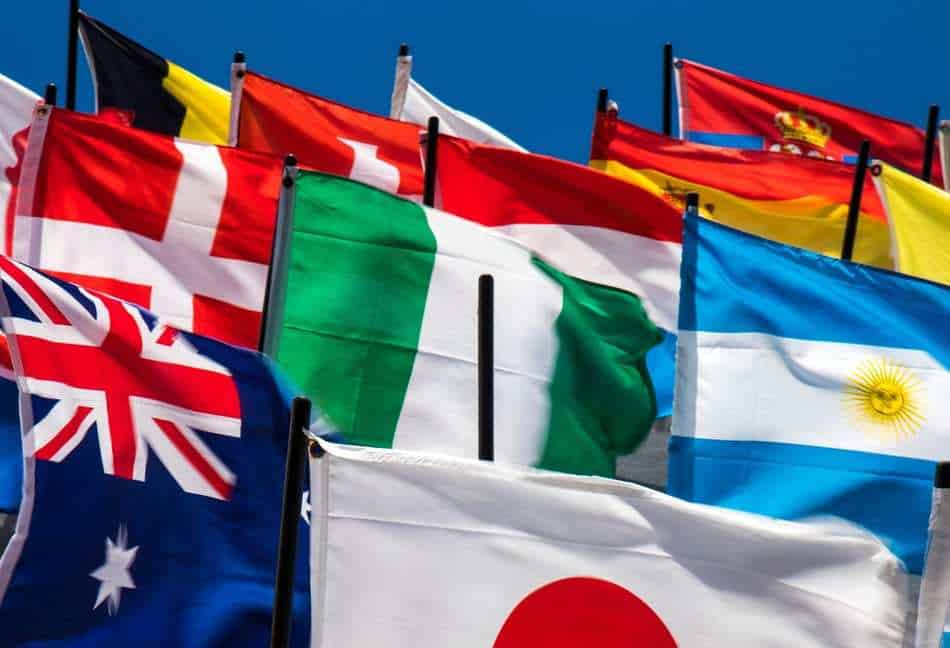
If you have read this website before, you will know that it is my goal to teach my kids Spanish and the culture that comes with it. Part of the culture is knowing and understanding the 21 Spanish speaking countries. Here, I wanted to research the Spanish speaking countries and their flags. Particularly, what the flags look like and the history behind them. So, I wrote a helpful article to look at the flags and understand their history.
What are the flags of the Spanish speaking countries? Below is a table of the flags of the 21 Spanish speaking countries.
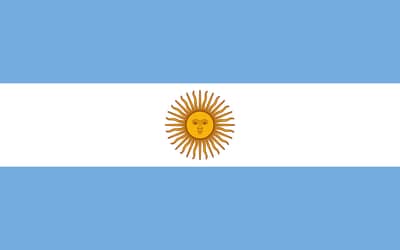
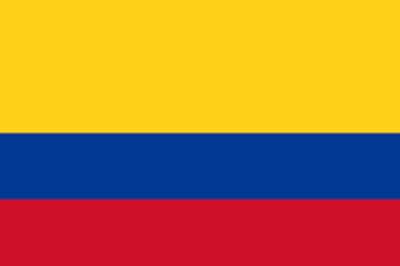
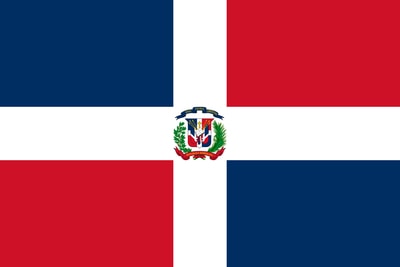
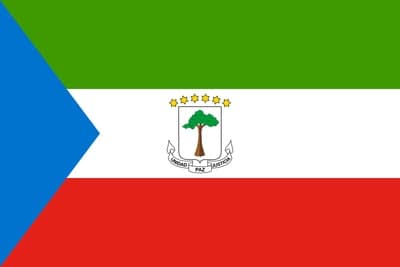
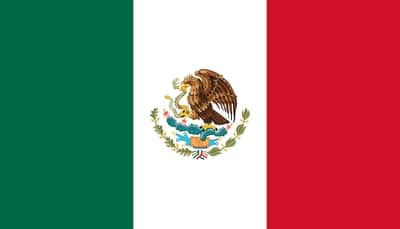
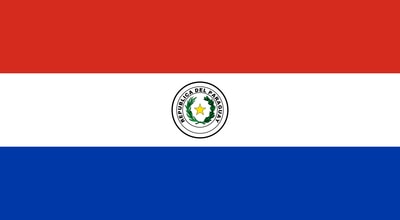
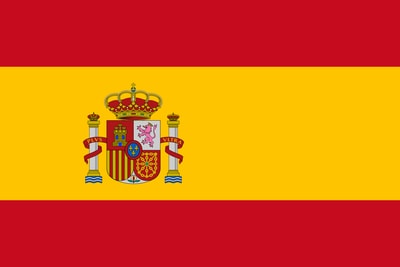
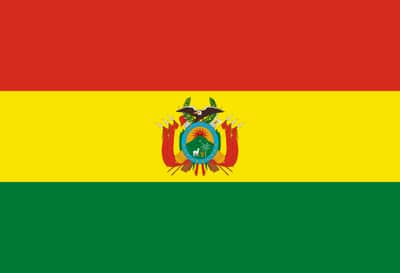
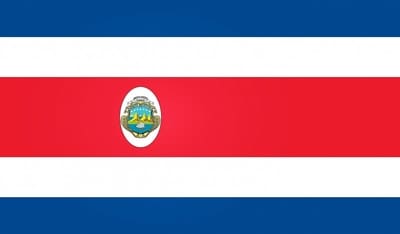
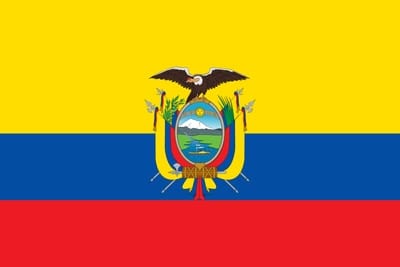
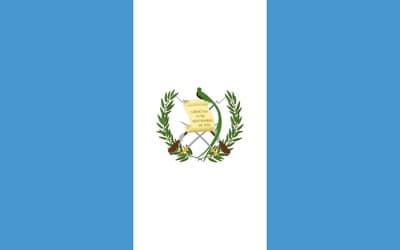
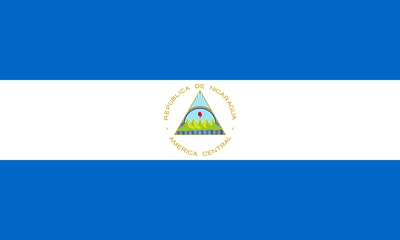
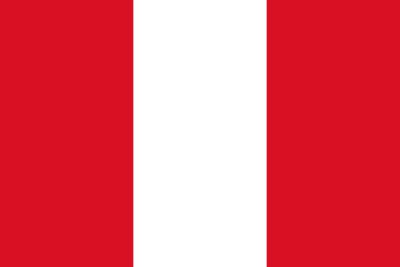
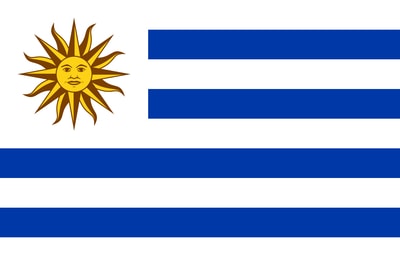
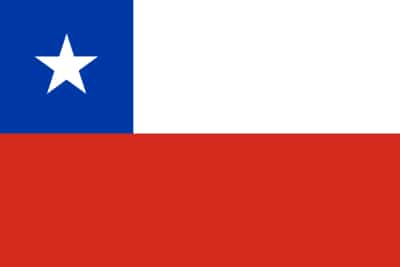

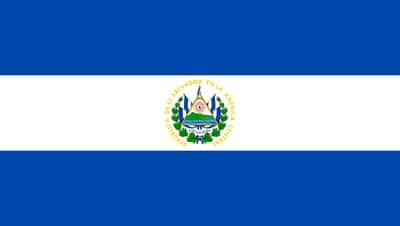
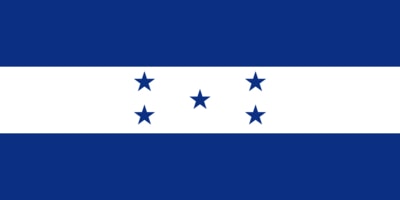
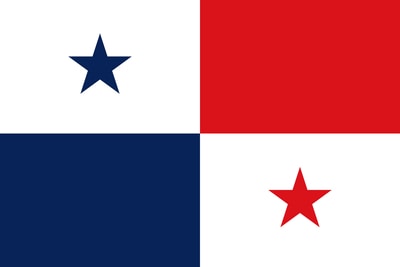
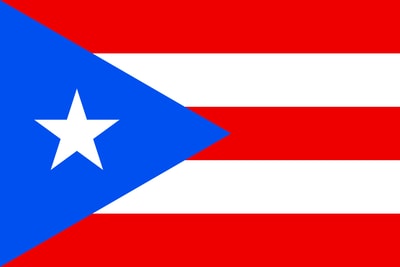
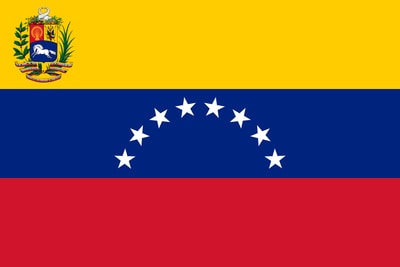
Flags of the Spanish Speaking Countries and A Brief History
The Spanish language came from Spain. Although Spain is the only country in Europe where Spanish is the official language, it has spread throughout the world. Since 1492, Spanish has spread to parts of North America, Central America, parts of the Caribbean, South America, and parts of the Pacific islands.
Today, Spanish is the official language in 21 countries and spoken in many others. In fact, Spanish is spoken by approximately 572 million people which makes it the second most spoken language in the world.
Now, let’s dive into the flags of these 21 Spanish speaking countries.
If you are also interested in learning about the capital cities of these 21 Spanish speaking countries, then check out an article I wrote here. You will be fascinated to learn about the struggles of each country and why some of these capital cities were chosen.
Argentina
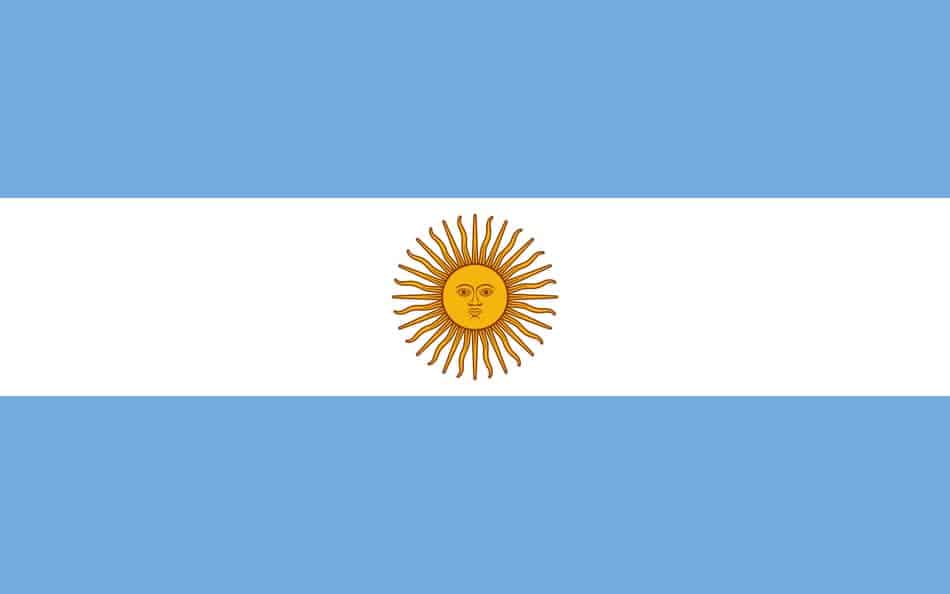
The flag of Argentina was created by Manuel Belgrano during the Argentine War of Independence. The flag was created in line with the Cockade of Argentina. The Cockade of Argentina was first raised at the city of Rosario on February 27, 1812, which was also during the Argentine War of Independence.
The design of the Argentine flag is not agreed upon by historians, however, popular belief attributes the colors of the flag to the sky, clouds, and sun. The colors of the flag are three horizontal stripes with light blue on the top and bottom. The center stripe is white. In the center of the white stripe there is an emblem known as the Sun of May, the golden sun. It is claimed that the Sun of May is a representation of the Inca sun god, Inti.
Bolivia
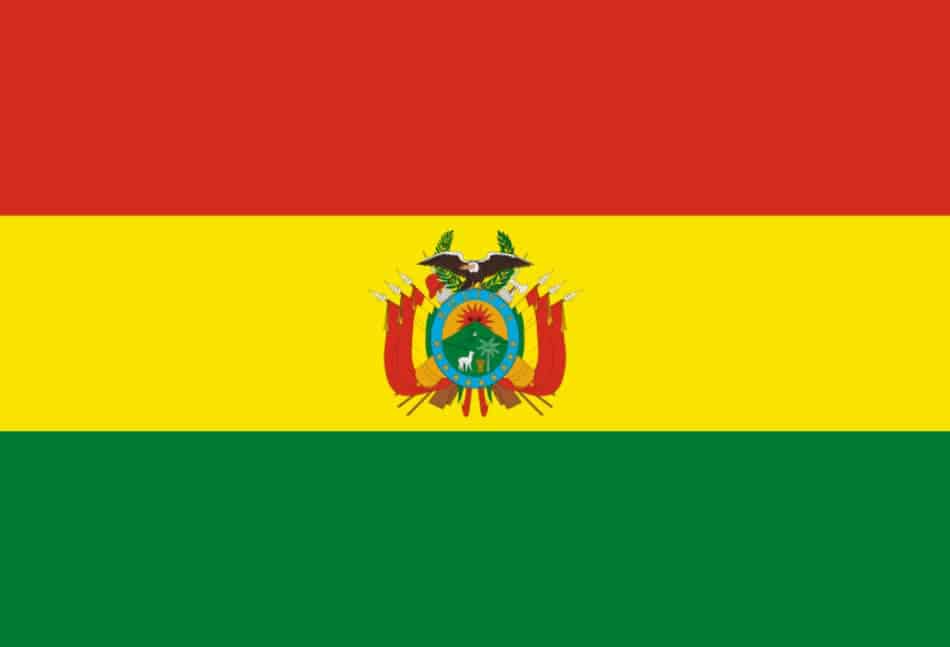
The national flag of Bolivia was originally adopted in 1851. The flag has three horizontal stripes of red, yellow, and green. In the center of the yellow stripe, the flag contains the Bolivian coat of arms.
The Bolivian flag is one of six flags that contains a depiction of its flag with the flag. The other countries are Haiti, Afghanistan, Ecuador, Costa Rica, and El Salvador.
The Bolivian flag’s coat of arms contain a naval design used by navy vessels on rivers and lakes. The coat of arms contain nine small gold stars that border the design. The nine stars represent the nine departments of Bolivia, which are basically the nine regions or states of Bolivia.
The red of the Bolivian flag represents the blood shed by the country’s brave soldiers. The yellow represents the country’s wealth, resources, and mineral deposit. The green represents the country’s hope, fertility, and richness of natural areas.
Chile

If you are traveling to Chile, try not to mistake the Chilean flag for the Texas flag. Yes, both flags are very similar to each other but there are some differences. The main difference being that the Texas flag has an extended blue section that runs vertically from top to bottom of the flag.
With the introduction above, yes, the Chilean flag is similar to the Texas flag. The Chilean flag has a horizontal red stripe across the bottom and a horizontal white stripe across the top. In the top left corner is a dark blue square with a white star in the middle.
The Chilean flag was adopted in 1817. In Spanish, the Chilean flag is known as La Estrella Solitaria (The Lone Star).
The star of the flag may represent a guide to progress and honor. The blue symbolizes the sky and the Pacific Ocean. The white of the flag is for the snow-covered Andes, and the red is for the blood spilled to achieve independence.
Colombia
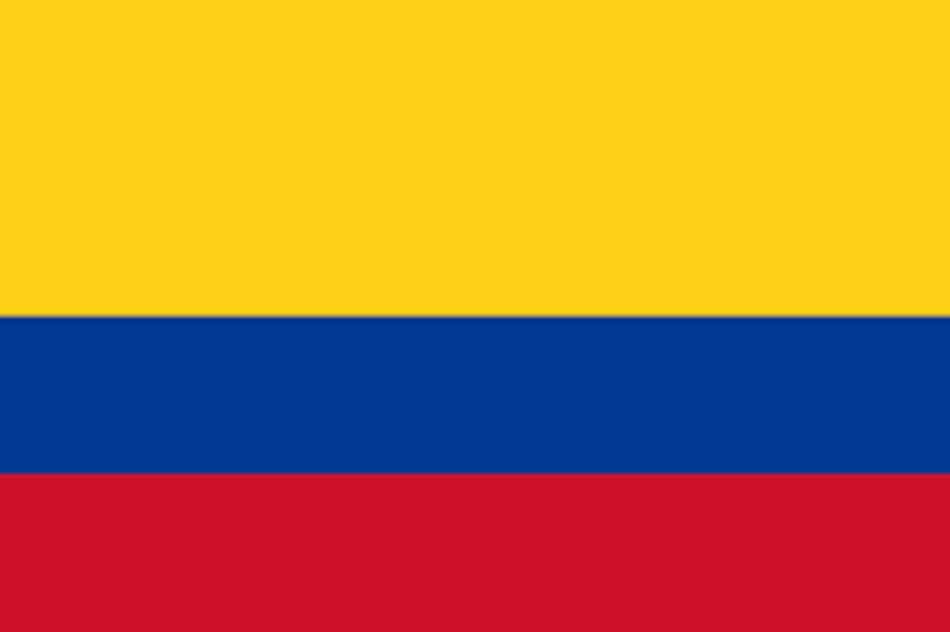
The flag of Colombia represents its independence from Spain that was gained in 1810. The flag of Colombia is modeled after the flag of Gran Colombia. The flag of Gran Colombia also served as models for the current flags of Ecuador and Venezuela.
The flag of Colombia has three horizontal sections of yellow, blue and red. The yellow section of the flag is the top half. The blue and red sections each make up a quarter of the flag.
The yellow of Colombian flag represents the country’s riches, including the Colombian soil, gold, sovereignty, harmony, justice and agriculture, as well as the sun. The blue of the Colombian flag represents the seas on the country’s shores, the rivers that run through it, and the sky above. Finally, the red of the Colombian flag represents the blood spilled for Colombia’s independence.
Costa Rica
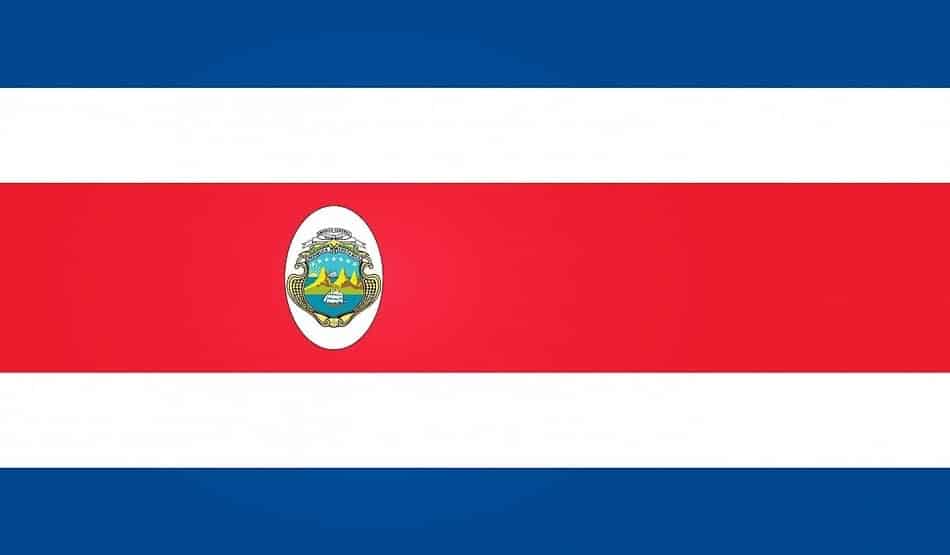
The Costa Rican flag was first created in 1848 by the then president’s wife. The flag contains horizontal stripes of blue, white, and red with the Costa Rican coat of arms in the red stripe. The flag design was modified a couple of times and was officially adopted by Costa Rica in 1906.
The blue color in the Costa Rican flag stands for the sky and opportunities. The white color of the flag stands for peace, wisdom and happiness. The red stands for the blood spilled by the martyrs in defense of the country. The coat of arms of the Costa Rican flag is a picture of the isthmus of Costa Rica between the Pacific Ocean and the Caribbean Sea, plus the three volcanoes in the country. Also, the seven stars on the coat of arms represent the seven provinces of Costa Rica.
The Costa Rican flag is similar to the flag of Thailand, the flag of North Korea Kalama and the transgender pride flag that was adopted in 1999.
Cuba

The first Cuban flag was initially designed in 1849. The Cuban flag was designed during the time of Spanish rule when some of the local Cubans wished for independence from Spain.
The flag consists of three horizontal blue stripes, two horizontal white stripes, an equilateral red triangle, and a lone white star within the red triangle.
Cuba gained independence from Spain in 1902 and that is when the Cuban flag was first flown. The Cuban flag was officially adopted in 1906 and has remained unchanged since then.
Dominican Republic
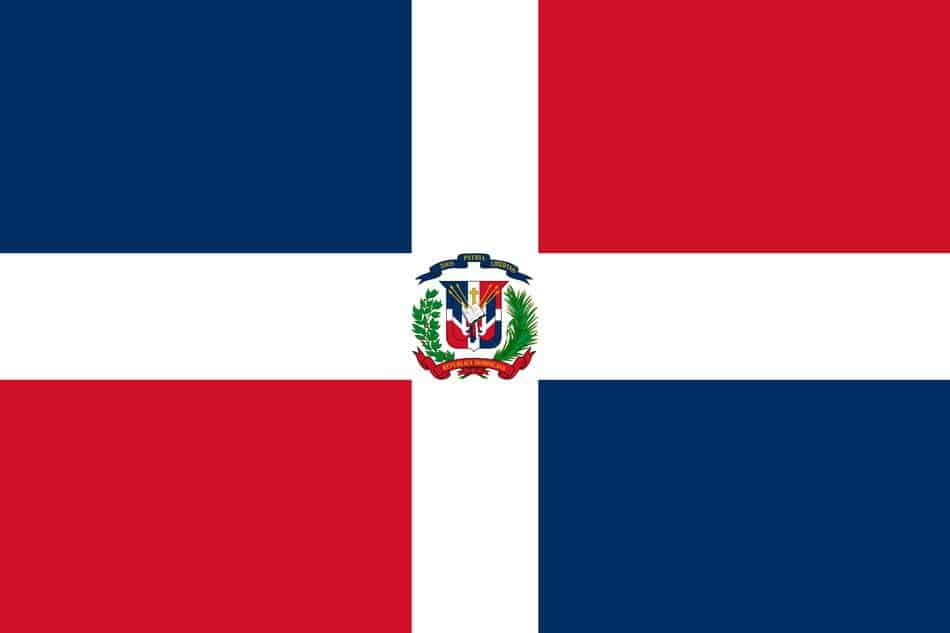
The flag of the Dominican Republic contains red, white, blue, and a coat of arms. The white part of the flag is a cross that contains the coat of arms in the middle. The blue parts of the flag are rectangles in the top left and bottom right of the flag. The red parts of the flag are rectangles in the top right and bottom left of the flag.
The coat of arms shows a bible, a gold cross , and six Dominican flags. There are branches of olive and palm around the shield. At the top of the coat of arms there is a ribbon with the motto “Dios,Patria!, Libertad” (“God, Country, Freedom”).
The blue on the flag is said to stand for liberty. Red represents the fire and blood involved in the country’s struggle for independence struggle. Finally, the white cross symbolizes that God has not forgotten the Dominican people.
Ecuador
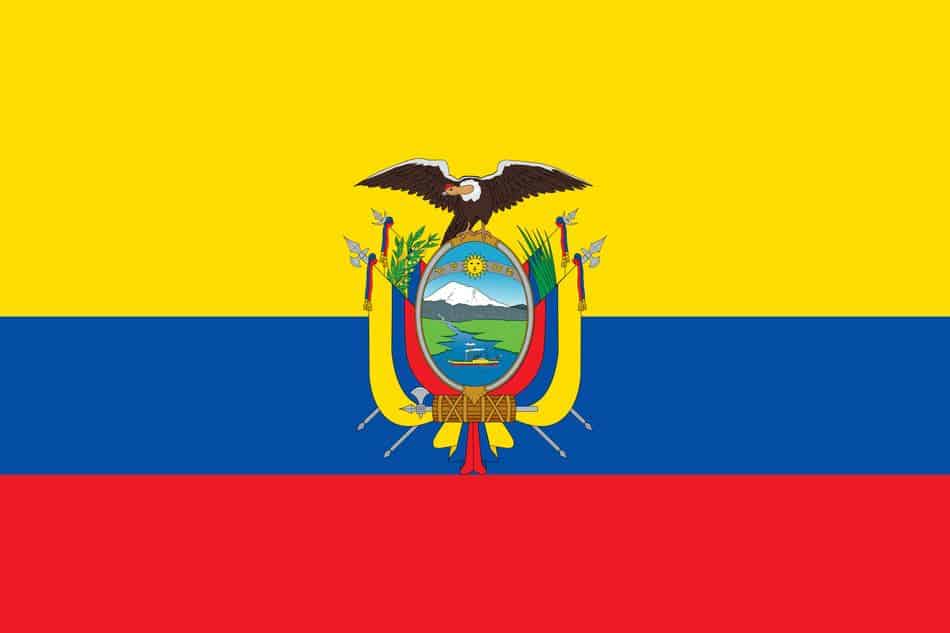
The national flag of Ecuador contains three horizontal bands of yellow, blue, and red. The yellow band is on the top of the flag and is twice the size of the other bands. The blue band is in the middle and the red band is on the bottom.
The yellow on the flag represents the crops and fertile soil. The blue represents the ocean and the clear skies. The red represents the blood spilled by Ecuador’s heroes who sacrificed their lives for the country’s independence.
In the center of the flag is the coat of arms for Ecuador. The coat of arms contains four Ecuadorian flag, an oval shield, and a large bird. The oval shield contains a picture of a steamboat ship on a river with the Chimborazo mountains in the background that is part of the Andes Range. The large bird on top of the shield is a condor that stretches his wings to symbolize the power, greatness and strength of Ecuador.
The flag was first adopted by law in 1835 and later again in 1860. The design of the current flag was finalized in 1900 with the addition of the coat of arms in the center of the flag.
El Salvador
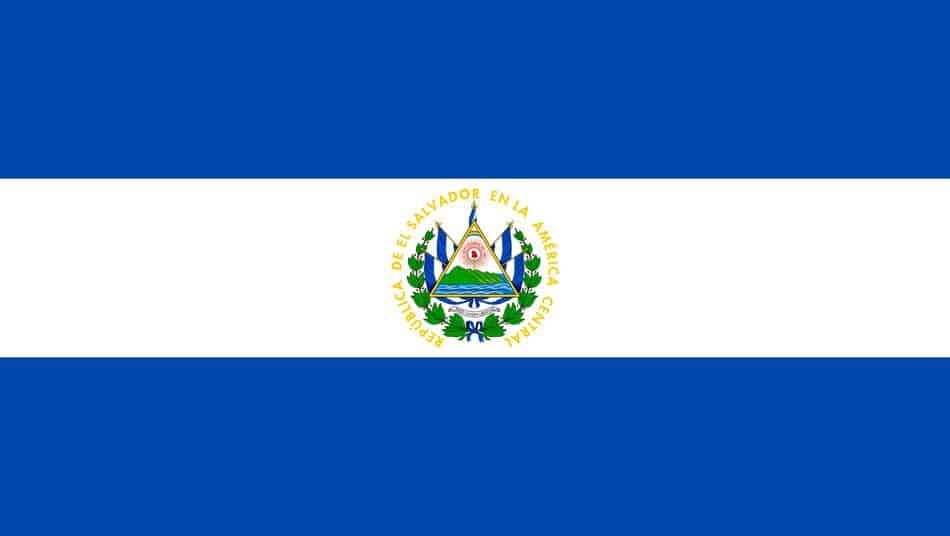
The flag of El Salvador is a horizontal triband of cobalt blue-white-cobalt blue. In the center of the white horizontal band is the coat of arms.
The coat of arms has five Salvadorian flags and a triangle with a depiction of El Salvador. Circling the outside of the coat of arms in golden amber are the words “REPÚBLICA DE EL SALVADOR EN LA AMÉRICA CENTRAL.” Another phrase in the coat of arms is ” DIOS UNIÓN LIBERTAD”, which is the Salvadorian motto that means “God, Union, Liberty.” Last, the flag contains the country’s date of independence of “15 DE SEPTIEMBRE DE 1821.”
The cobalt blue stripes on the flag represent the great sky and the two oceans on either side of Central America. The white represents peace, concordia, and solidarity in the world. The current flag of El Salvador has been in use since 1912.
Equatorial Guinea
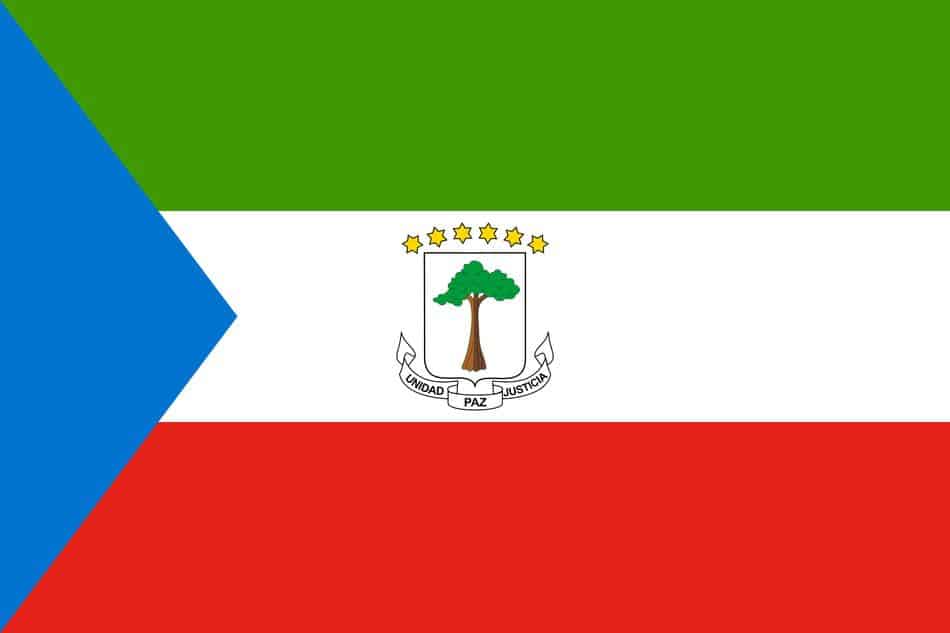
The flag of Equatorial Guinea was adopted on August 21, 1979. This same flag was first flown after the independence of Equatorial Guinea is 1968. The flag was modified under the rule of dictator, Francisco Nguema, whose regime began in 1973. Nguema’s dictatorship ceased to exist on August 21, 1979, which is the same day the that original flag was restored.
The flag of Equatorial Guinea is a horizontal triband of green, white, and red with a blue triangle on the left side of the flag. In the center of the white section of the flag is the country’s coat of arms.
The coat of arms contains six gold stars, which represent the mainland of the country and its five islands. Also, the coat of arms contains a silver shield with a silk-cotton tree that represents the treaty signed under the tree between Spain and the local ruler that marked the beginning of colonial rule. Last, the country’s motto is inscribed on the coat of arms where it states “Unidad, Paz, Justicia”, which means “Unity, Peace, Justice.”
Guatemala
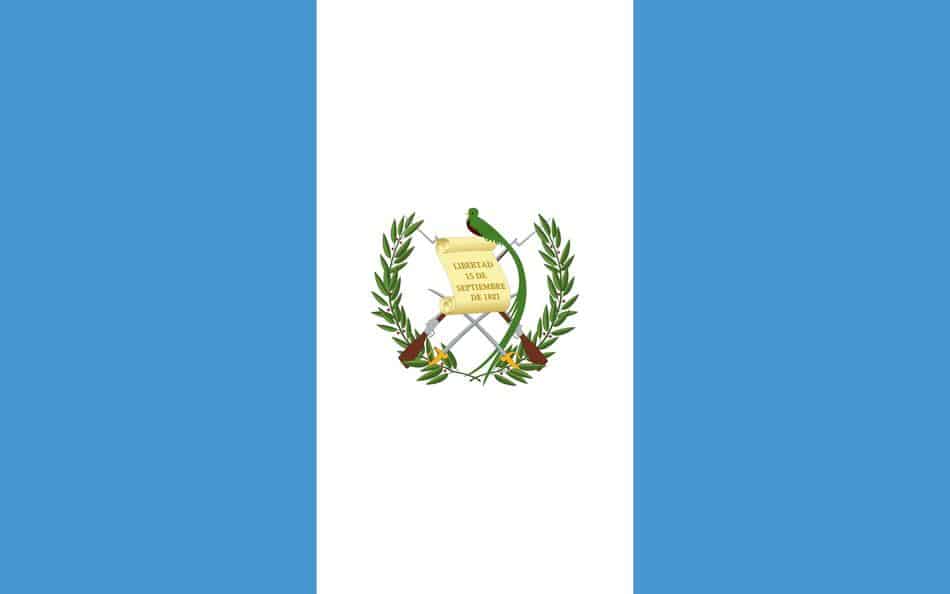
The flag of Guatemala is based upon the flag flown by the Federal Republic of Central America from 1823 to 1841. The Federal Republic of Central America was a group of countries that was formed following its independence from Spain. The countries included Guatemala, Costa Rica, El Salvador, Honduras, Nicaragua, and the southern Mexican state of Chiapas.
The current flag of Guatemala was adopted in 1871. The flag contains a triband of vertical stripes. The stripes are sky blue, white, and sky blue. In the center of the white stripe is the coat of arms. The sky blue color on the flag represents the sky over Guatemala and the two oceans on either side of the country, which are the Pacific Ocean and the Atlantic Ocean (Caribbean Sea). The white represents peace and purity.
The coat of arms in the center of the flag of Guatemala contains the resplendent quetzal, the national bird of Guatemala that symbolizes liberty. A parchment scroll in the coat of arms shows Central America’s independence from Spain on September 15, 1821. The crossed rifles symbolizes the country’s willingness to defend itself. A bay laurel crown in the coat of arms represents victory and crossed swords symbolize honor.
Another fun fact about Guatemala is that they have incorporated the resplendent quetzal into their currency, as well. In fact, the currency of Guatemala is named Quetzal (after the national bird, of course) with the symbol of the currency being Q.
The currencies and history of the Spanish speaking countries is fascinating. I had no idea how much history was behind any of these currencies. If you would like to learn more about the currencies of the other Spanish speaking countries, click here to check out the article I wrote about the currencies of the 21 Spanish speaking countries!
Honduras
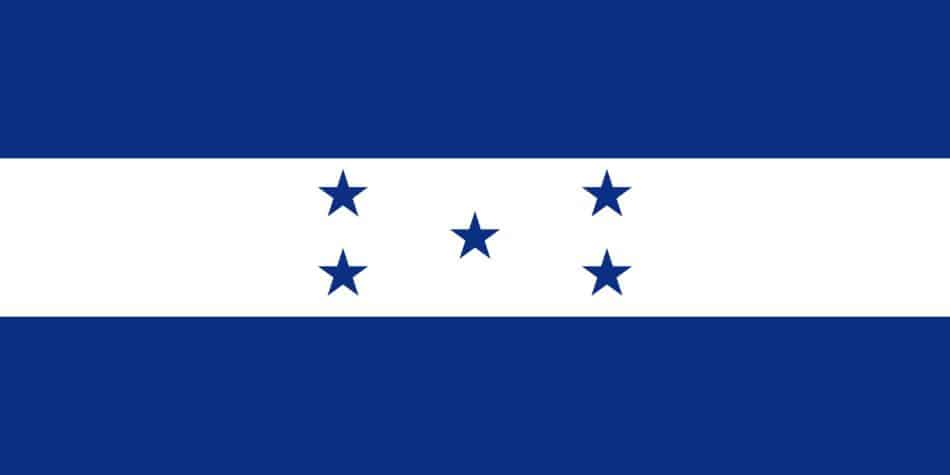
The flag of Honduras was adopted on March 7, 1866, based on the flag of the Federal Republic of Central America. Honduras was a part of the Federal Republic of Central America beginning in 1823, along with Costa Rica, El Salvador, Guatemala, and Nicaragua.
The flag of Honduras is very similar to the flag of the Federal Republic of Central America because it has three horizontal bands of equal width in blue, white, and blue again. In the center of the flag of Honduras are five blue stars that represent the former countries in the Federal Republic of Central America, which were Honduras, Costa Rica, El Salvador, Guatemala, and Nicaragua.
The blue bands on the flag of Honduras represent the Pacific Ocean and the Atlantic Ocean (Caribbean Sea) that are on either side of the country. The blue color also represents the blue sky and brotherhood. The white on the flag of Honduras represents the land between the two bodies of water, along with peace and prosperity of its people, and purity of thoughts.
Mexico
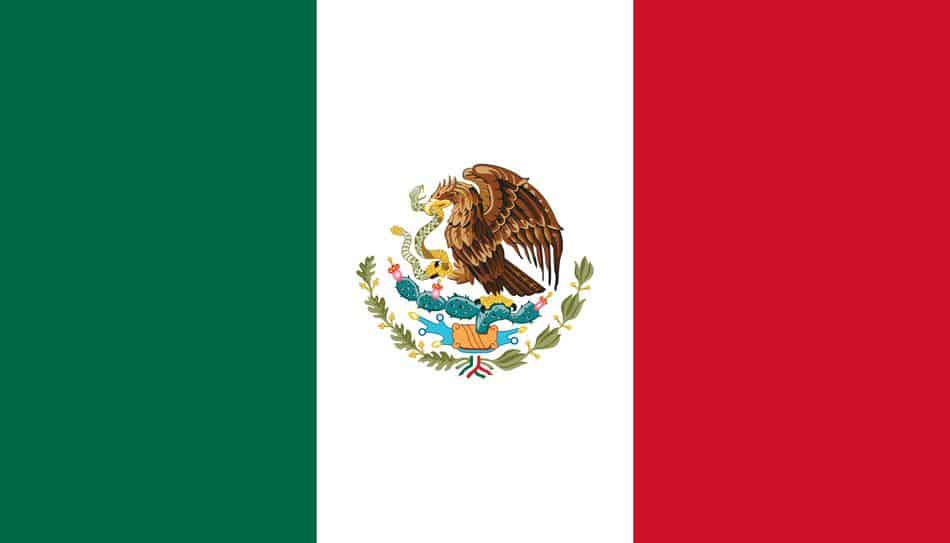
The flag of Mexico is a vertical triband of green, white, and red with the Mexican coat of arms in the center of the white stripe. The flag of Mexico was adopted in 1821 after its independence from Spain that followed the War of Independence. The flag colors have stayed the same since 1821, however, the coat of arms was most recently updated in 1968.
The coat of arms of the flag of Mexico is based on the Aztec symbol for the city of Tenochtitlan (now Mexico City), which was the center of the Aztec empire. The coat of arms recalls a legend of an eagle sitting on a cactus eating a snake, which in turn signaled to the Aztec where they should found their city.
Nicaragua
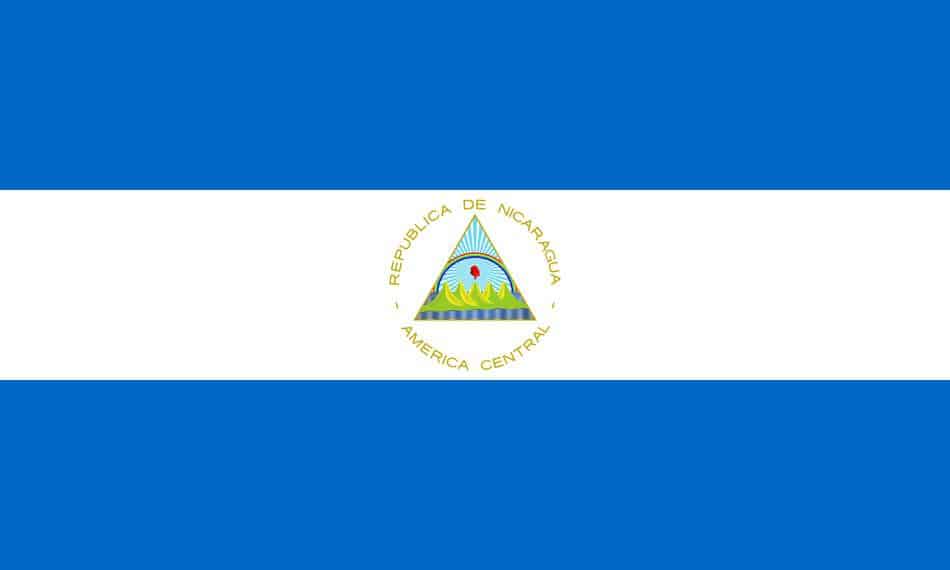
The flag of Nicaragua is based on the flag of the Federal Republic of Central America. They are nearly identical. Nicaragua first used its variation of the flag in 1908, but it was not officially adopted by the country until 1971.
The flag of Nicaragua is inspired by the flag of the Federal Republic of Central America and also looks very similar to the flag of El Salvador. The flag of Nicaragua is a triband of three horizontal stripes of blue-white-blue. In the center of the white stripe is a coat of arms.
Around the coat of arms are the phrases “REPUBLICA DE NICARAGUA” and “AMERICA CENTRAL.” Inside these phrases is a triangle that contains five volcanoes surrounding by two bodies of water on either side. The five volcanoes represent the five countries that were part of the Federal Republic of Central America.
Above the volcanoes in the coat of arms is a red hat, which symbolizes the Cap of Liberty and national freedom. Above the Cap of Liberty are rays of sun and a rainbow which symbolize the bright future to come.
Panama
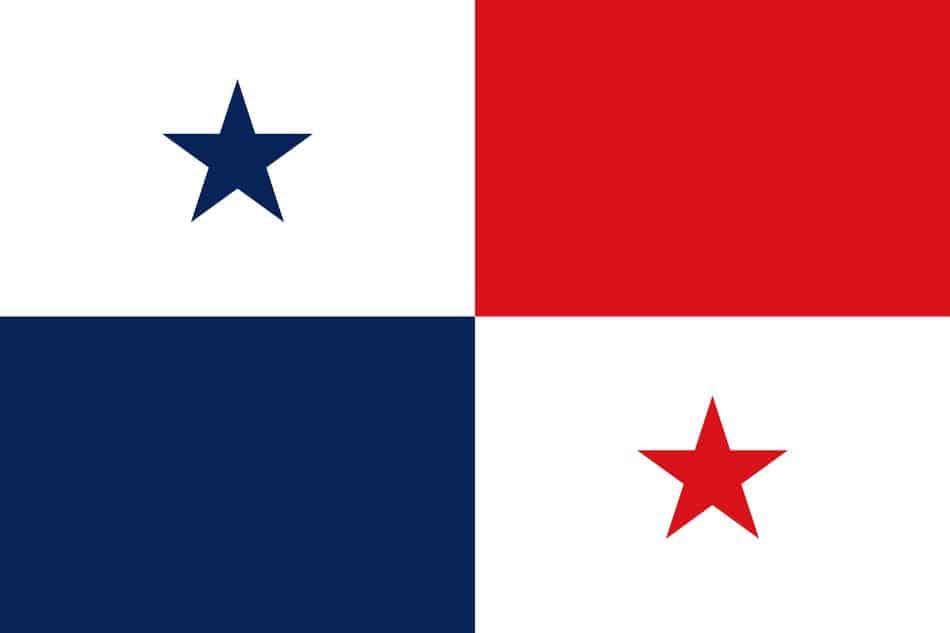
Before 1903, Panama was a part of the Republic of Colombia. In November of 1903, Panama seceded from the Republic of Colombia and became its own sovereign nation. On November 1, 1903, the original flag of Panama was made.
The current flag of Panama was adopted in 1925. It is a rectangle flag divided into four quarters. The top-left of the flag is white with a blue star in the middle. The bottom-left is blue. The bottom-right of the flag is white with a red star. Last, the top-right of the flag is red.
The flag of Panama was to represent the political situation during that time. The blue was meant to symbolize the Conservative Party and the red to symbolize the Liberal Party. The white represented peace and purity. The blue star represents purity and honesty of the life of the country. The red star represents the authority and law in the country. While the stars together symbolize the new republic.
Paraguay
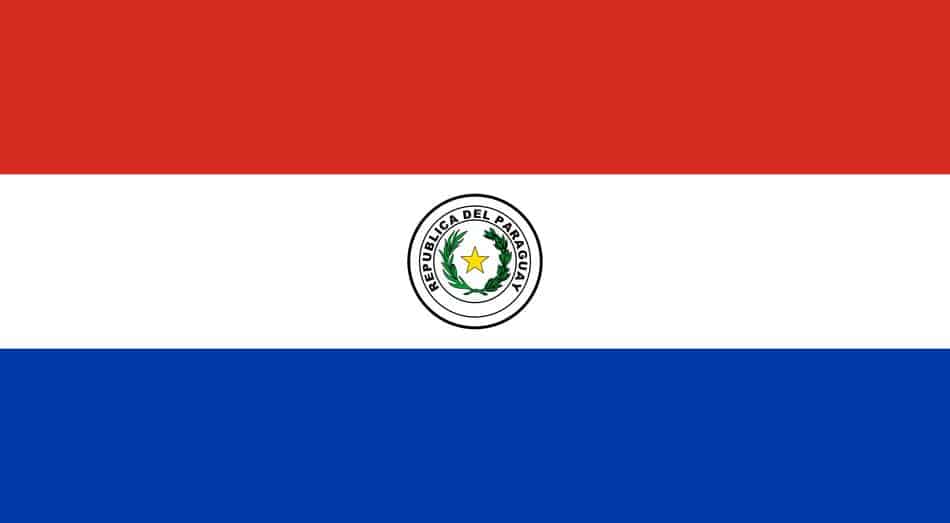
The current flag of Paraguay was first adopted in 1842. The flag contains a triband of horizontal stripes that are red-white-blue. The colors of the Paraguayan flag were inspired by the Dutch flag, which are believed to symbolize independence and liberty.
What makes the flag of Paraguay unique is that the front and back of the flag are different. On the front of the flag is the national coats of arms of Paraguay. On the back of the flag is the seal of the treasury. The coat of arms and the seal of the treasury are both in the center of the white stripe.
The national coat of arms has the phrase “REPUBLIC DEL PARAGUAY” that wraps around it. In the center of the coat of arms is a yellow star surrounded by a green wreath of palm and olives tied together.
The seal of the treasury on the back of the flag contains a yellow lion below a pole with a red cap (similar to the Cap of Liberty) that symbolizes courage. Around the seal of the treasury is the phrase “PAZ Y JUSTICIA”, which means Peace and Justice.
Peru
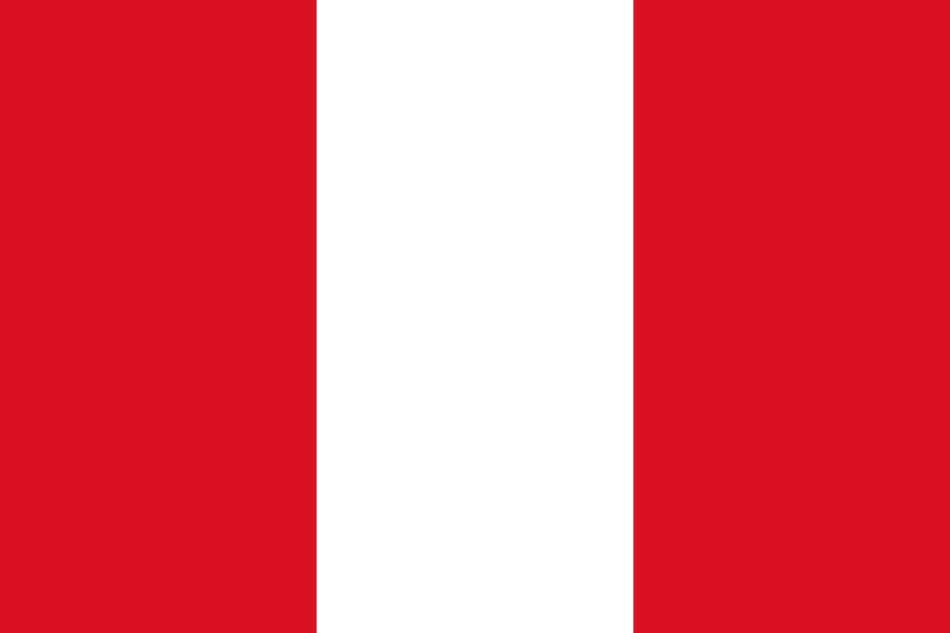
The flag of Peru is simple in nature. It is a flag that contains a triband of red outer bands and a white inner band. The flag of Peru was adopted in 1824 and modified to its current state in 1950. The flag was flag was stripped down to its de facto form so that it would be easier to make.
Before the final change in 1950, the flag of Panama contained a coat of arms. However, even today, Panama uses variant flags of the national ensign and war flag that were created for exclusive uses.
Flag day in Peru is June 7th each year, which is the anniversary of the Battle of Arica. The Battle of Arica was fought on June 7, 1880, between the forces of Chile and Peru as part of the War of the Pacific between Chile and a Bolivian-Peruvian alliance. Chile won the Battle of Arica and occupied the city. In fact, Arica was never occupied again by Peru and was officially ceded to Chile under the Treaty of Lima in 1929.
Puerto Rico

The flag of the Commonwealth Puerto Rico is similar to the flag of Cuba. It contains five alternating stripes of red-white-red-white-red with a navy blue isosceles triangle on the left side of the flag with a white star in the middle of the triangle. The flag of Cuba is similar in design with its five alternating stripes and isosceles triangle, however, the colors of blue and red are inverted.
The three red stripes of the flag of Puerto Rico represents that blood that nourishes the three branches of government. The two white stripes of the flag represent individual liberty and the rights of man. The white star represents the Commonwealth. The blue triangle represents the ocean and sky. Finally, the three sides of the triangle represent the three branches of government.
The flag was originally designed in 1895 by a group of Puerto Ricans exiled in New York. However, until 1898, the flag flown over Puerto Rico was the flag of Spain. In 1898, Spain seceded Puerto Rico to the United States. Finally, the current flag of Puerto Rico was adopted by the Commonwealth in 1952.
Spain
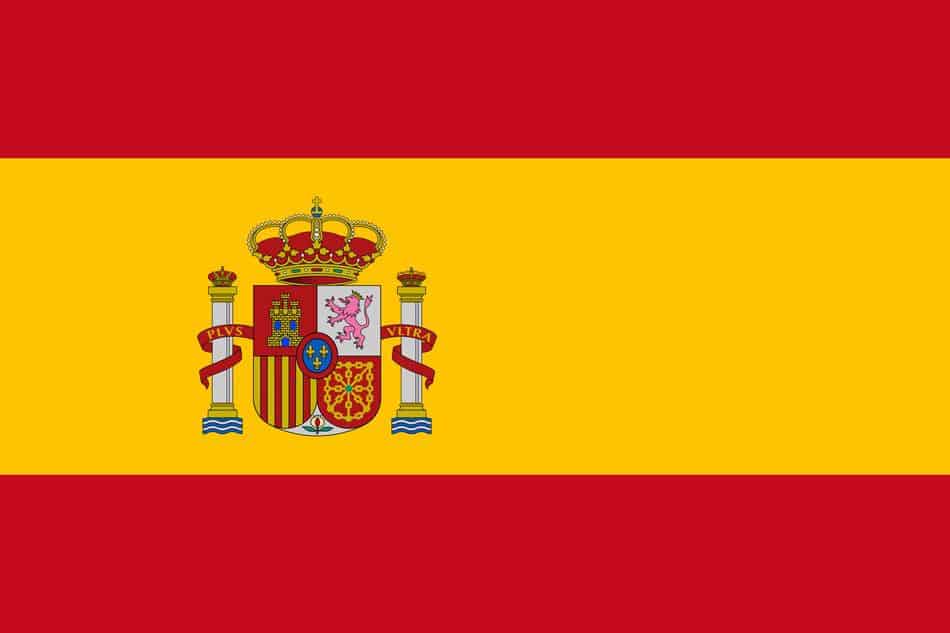
The basic flag of Spain was established in 1785 by King Charles III. During the 1700s, most of the European countries had flags that were mostly white. This was an issue since many European countries were at war with each other at various times, so you could not know the origin of a ship until you were almost directly on top of it. Therefore, King Charles III required that 12 flags be designed and he chose the currently flag.
The flag of Spain contains horizontal stripes of red-yellow-red. The center yellow stripe is twice the size of a red stripe. These red-yellow-red stripes have stayed the same since 1785, except during the Second Spanish Republic from 1931 to 1939. Otherwise, the only changes to the flag have been the various coat of arms on the flag. The current flag of Spain has the coat of arms left of center in the yellow stripe.
The current design of the flag of Spain dates back to its adoption in 1981, when the coats of arms was last updated. The coat of arms contains the Pillars of Hercules on either side with the words “Plus Ultra” (“Further Beyond”) wrapped around the pillars. The phrase “Plus Ultra” represents the discoveries of Spanish explorers.
The Pillars of Hercules surround a shield that displays a three-towered castle to signify the Kingdom of Castile, a lion wearing a crown represents the Kingdom of León, a shield with red and yellow vertical stripes to represent the Crown of Aragon, chains linked together to represent the Kingdom of Navarre, a flower at the bottom of the shield represents the Kingdom of Granada in southern Spain, and three fleurs-de-lis in an oval represent the reigning Spanish family of the House of Bourbon-Anjou.
The lion is a symbol of the Kingdom of León that was supposedly used by a Roman legion in the 1st century AD. The shield with red and yellow vertical stripes represents the Crown of Aragon and modern Catalonia that shows a 9th-century event where the grandson of Charlemagne honored the count of Barcelona for his heroism. Last, the flag update in 1981 included the Spanish Royal crown displayed above the coat of arms to honor the role of the monarchy in modern Spanish.
Uruguay

The flag of Uruguay contains nine alternating stripes of that are white and blue. There are five white stripes and four blue stripes each of equal width. The top left corner of the flag is a white square with a golden sun in its center that has 16 rays of sunshine extending from its center. The golden sun also has a face in the center of it.
The golden sun on the top left corner of the flag is the “Sun of May”, which represents Inti, the sun god of Inca religion. It symbolizes freedom and independence. The nine white and blue stripes represent the nine provinces or departments of Uruguay. Today, there are 19 departments of Uruguay.
The flag of Uruguay was first adopted by law on December 16, 1828, and the flag contained 19 stripes. On July 11, 1830, the flag was changed to its current design that reduced the number of stripes to nine. The flag of Uruguay is one of the world’s oldest flags.
The colors of the flag of Uruguay were inspired by the flag of Argentina. However, the design of the flag of Uruguay, in particular the white and blue stripes, were influenced by the flag of the United States.
Venezuela
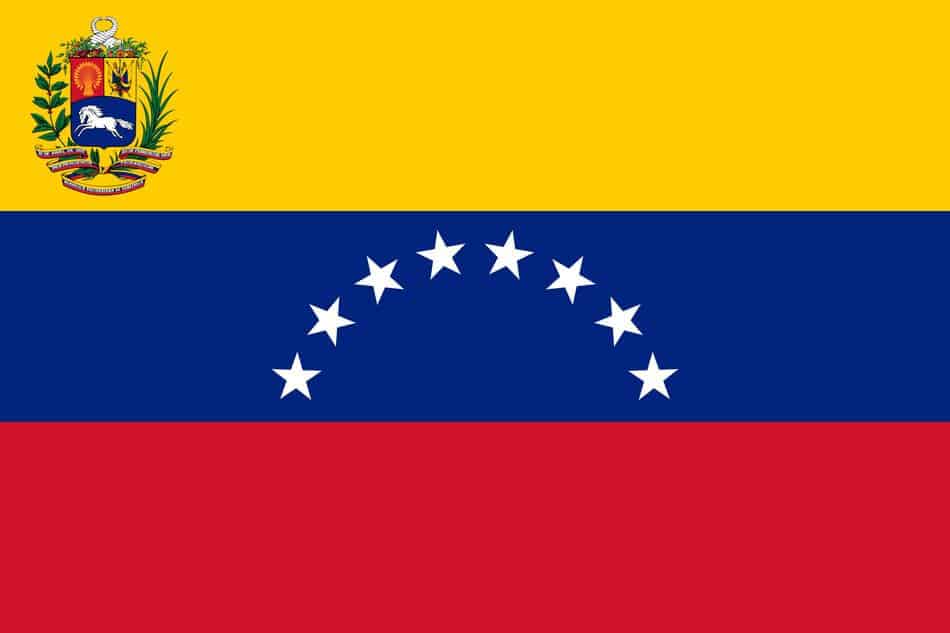
Francisco de Miranda is credited with the initial design of the flag of Venezuela in the early 1800s. Miranda’s flag was used during the unsuccessful expedition in 1806 to liberate Venezuela. However, Venezuela was liberated from Spain five years later in 1811 and Miranda’s flag was adopted by Venezuela.
The flag of Venezuela contains three horizontal stripes of yellow, blue, and red that are all of equal width. In the middle of the blue stripe are eight white stars displayed in an arch. In the top left corner of the flag is the coat of arms.
The yellow on the flag represents the richness of the country and the wealth of the country’s soil, gold, sovereignty, harmony, justice and agriculture. The blue represents the Caribbean Sea and the beaches of Venezuela. Last, the red represents the blood spilled in gaining independence from Spain.
The coat of arms on the flag of Venezuela is divided into the colors of the flag, which are yellow, blue, and red. Above the shield for the coat of arms are two crossed cornucopias pouring out wealth. The coat of arms is flanked by an olive branch and a palm branch that are tied to a large band at the bottom of the coat of arms. The large band contains the dates of independence from Spain and civil war in Venezuela known as The Federal War.
The red portion of the coat of arms in the top left corner contains a picture of wheat that represents the union of 20 states of the Republic and their wealth. The yellow section in the top right corner is a symbol of triumph of war where weapons and two national flags are tied together. Last, the blue section on the bottom contains a wild white horse running free and symbolizes freedom and independence.
The flag of Venezuela was the inspiration for the flags of Colombia and Ecuador.
